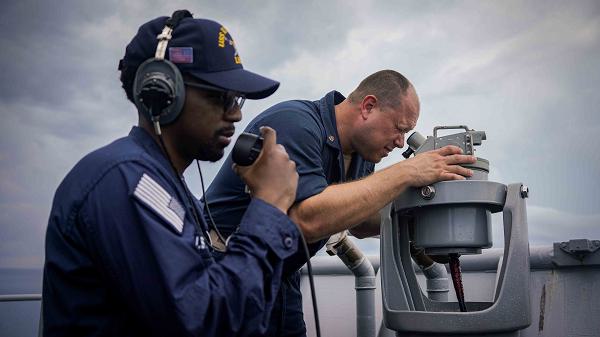
Puerto Princesa, Philippines. (June 6, 2024): Despite all the high-tech developments of late, determining the bearing and relaying the distance of enemy targets is still done in a very traditional way, In this photo by MC2 Sang, Kim, Chief Quartermaster Matthew Frey, right, looks through a telescopic Alidade as Quartermaster 3rd Class James Handy, left, operates a Sound Powered Telephone during a sea and anchor evolution aboard the amphibious dock landing ship USS Harpers Ferry.
A telescopic Alidade is an instrument used for determining direction or “bearing” of a distant object. In navigation, a bearing is the relationship between an object and magnetic north on a compass. For example, an object that is due East from your position would be reported at an angle (or azimuth) of ninety degrees. The operator peers through a telescope to “sight” the object while reading its location in degrees at the same time.
In the early days, Alidades were used in fire towers for sighting the bearing to a forest fire. The observer looks through two sights while adjusting them until they are aligned with the smoke from the fire. These sighting devices have likewise served aboard U.S. Navy vessels for decades.
The Alidade readings are relayed to key personnel onboard via a Sound Powered Telephone, a technology that came into service during World War II. These communication devices allow users to speak to each other with a handset that is like a conventional telephone but doesn’t require the use of external power. First employed on Navy ships in 1944, the phones form a circuit to allow communication between key locations on a vessel if power is unavailable.
Typically there would be five lookouts stationed at key points aboard ship (stern, port, starboard, and pilot house) to report visual contacts to the Combat Information Center (CIC). The rugged and reliable Sound Powered Telephone remains a staple on Navy Ships despite numerous attempts to replace it. It is simple, doesn’t require external power, and is not affected by radio interference.
Despite the explosion of technology since 1944, the Alidade and the Sound Powered Telephone get the job done in a most traditional way.


